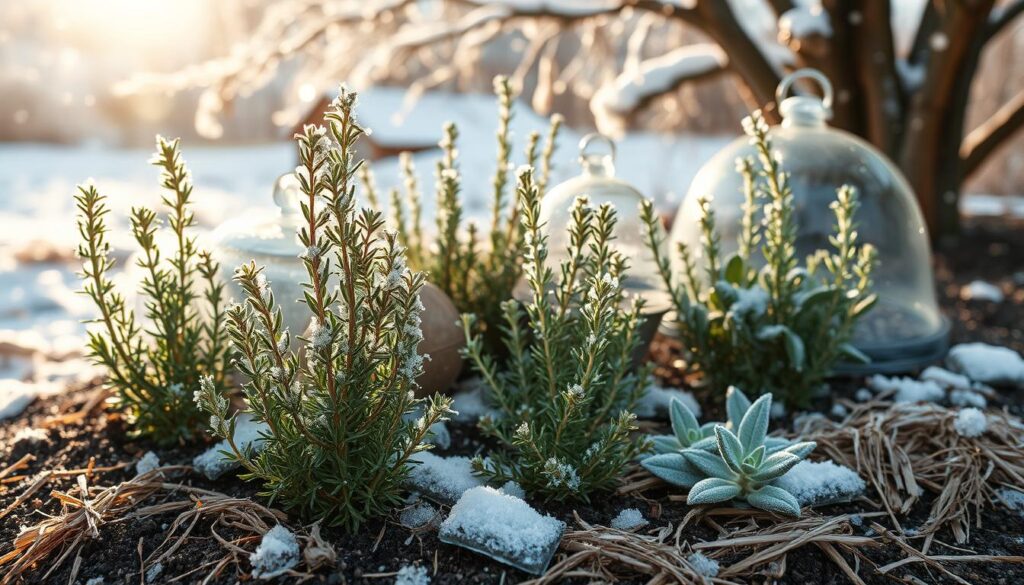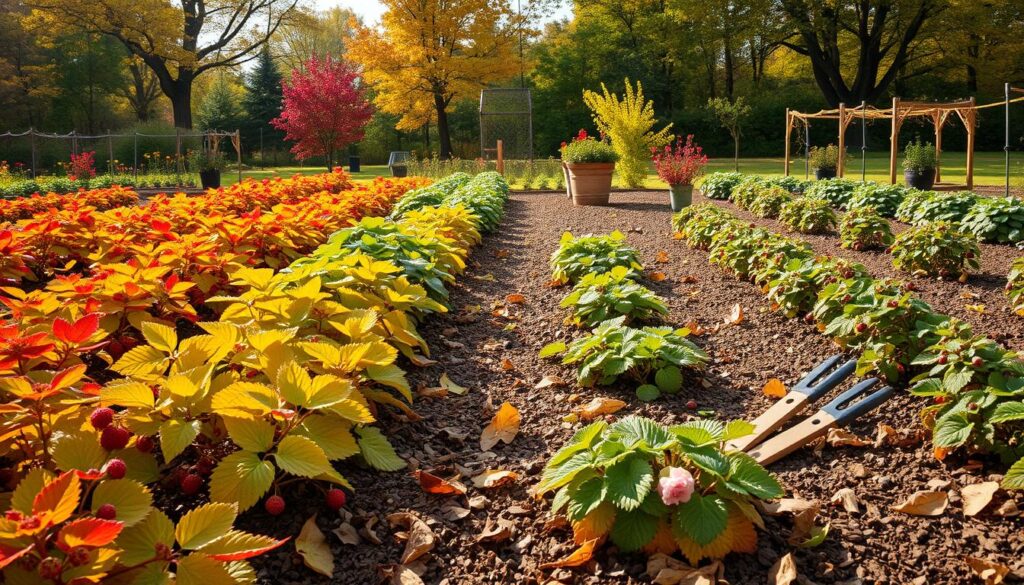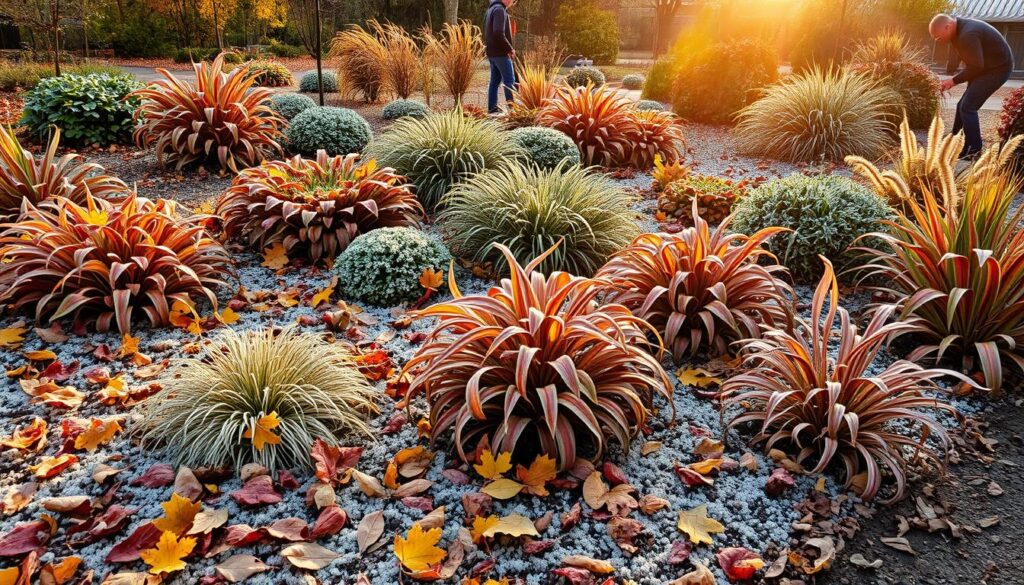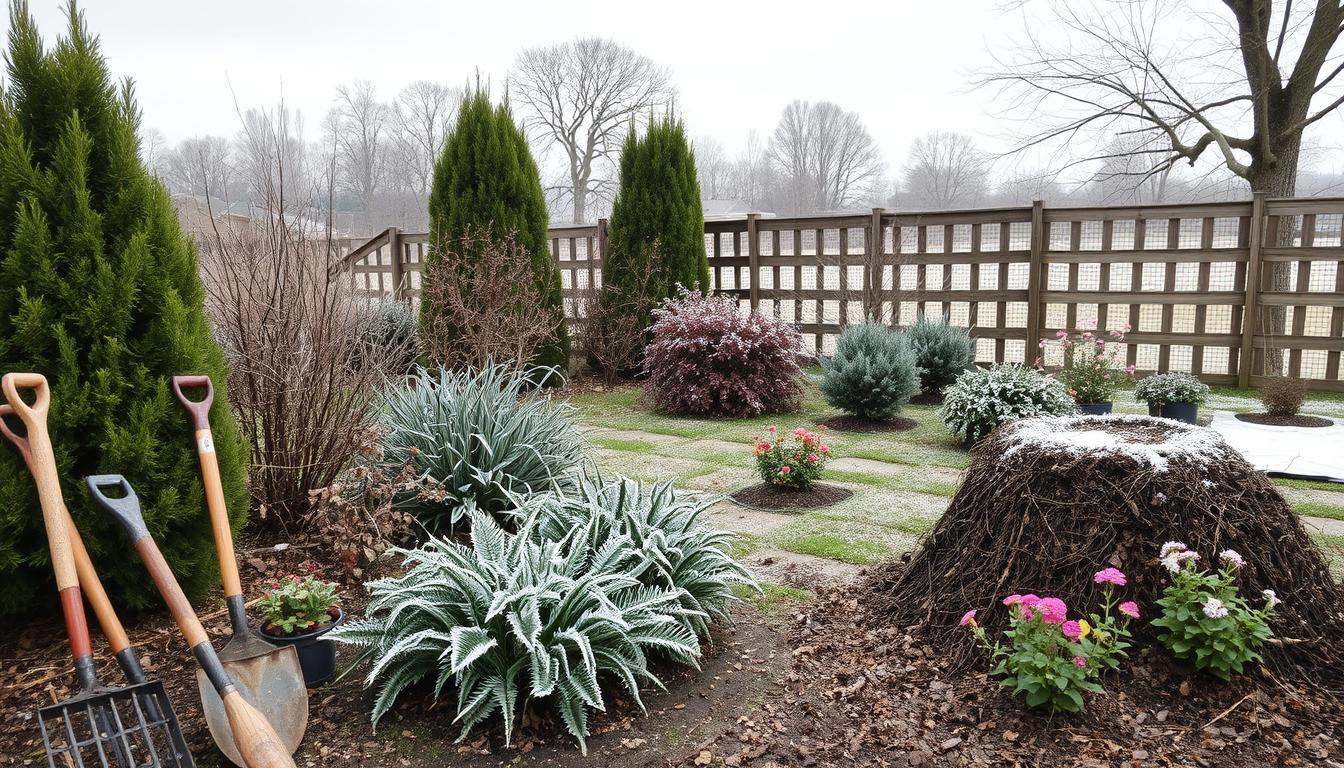As summer fades and days shorten, it’s time to get my garden ready for winter. This means harvesting crops, storing them, and protecting plants. It also involves preparing garden beds for the cold. By doing this, I ensure my plants and soil are cared for, ready for a great spring.
Key Takeaways
- Properly preparing your garden for winter is a crucial task for ensuring a successful growing season in the spring.
- Winterizing your garden involves a range of activities, from harvesting and storing crops to protecting delicate plants and preparing garden beds.
- By taking the time to complete these essential winterization tasks, you can help your plants and soil thrive during the cold months, leading to a vibrant and productive garden in the following year.
- Regular maintenance and careful planning are key to a successful winter garden preparation process.
- Implementing best practices for winterizing your garden can help prevent damage, reduce the workload in the spring, and promote overall plant and soil health.
Harvesting and Storing Crops
As the growing season ends, it’s crucial to harvest and store your garden’s crops right. Knowing how different vegetables handle cold is key. This ensures they’re cared for well before the first frost.
Tender Vegetables
Vegetables like tomatoes, zucchini, peas, beans, winter squash, and pumpkins don’t like frost. Harvest them before the first frost. Remove the plants and any leftover debris, making sure to get rid of diseased plants to stop disease spread.
Hardy Vegetables
Hardy vegetables can handle hard frosts, between 25° to 28°F. Brussels sprouts can be buried in hay or leaves. Cooking greens like kale and collards get sweeter with frost. Broccoli, spinach, and garlic also survive winter without extra protection.
Semi-Hardy Vegetables and Root Crops
Semi-hardy veggies like cabbages, Swiss chard, arugula, leeks, mustard greens, cauliflower, English peas, and Kohlrabi can handle light frosts, 29° to 32°F. They might need protection like a cold-frame or row cover. Root crops like carrots, turnips, beets, rutabagas, and parsnips can stay in the garden after frost. Dig them up and store before the ground freezes. Potatoes can stay in the soil but must be dug up before it freezes and cured for storage.
| Vegetable Type | Frost Tolerance | Examples |
|---|---|---|
| Tender Vegetables | Cannot tolerate frost | Tomatoes, zucchini, peas, beans, winter squash, pumpkins |
| Hardy Vegetables | Withstand hard frosts (25°-28°F) | Brussels sprouts, kale, collards, broccoli, spinach, garlic |
| Semi-Hardy Vegetables | Tolerate light frosts (29°-32°F) | Cabbages, Swiss chard, arugula, leeks, mustard greens, cauliflower, English peas, Kohlrabi |
| Root Crops | Can remain in the garden after frost | Carrots, turnips, beets, rutabagas, parsnips, potatoes |
Understanding the cold tolerance of different vegetables helps gardeners harvest and store their crops well. This way, they can enjoy the most from their winter garden.
Protecting Herbs for Winter
As winter gets closer, it’s time to get your herb garden ready. Some herbs like sage and thyme can handle the cold well. But others, like rosemary and basil, need more help.
Here are some tips to help your herbs make it through winter:
- Avoid major pruning between early August and early September to prevent stimulating new, vulnerable growth.
- Apply a 3-4 inch layer of mulch to outdoor herbs after the first freeze to aid in their overwintering.
- Cover plants before a freeze in regions above USDA zone 6 to protect woody perennial herbs like rosemary.
- Cut back hardy perennials like parsley and chives to 4-6 inches from the ground after a hard freeze (28°F or below).
- Tender perennial herbs like curry plants, lemon verbena, and pineapple sage may need extra care to survive freezing temperatures.
With the right care, most herbs can thrive in your garden for years. But, annual herbs like dill and coriander will die with the first frost.
| Herb | Hardiness | Winter Care |
|---|---|---|
| Sage | Hardy perennial | Mulch after first freeze |
| Rosemary | Tender perennial | Cover before freeze in zones above 6 |
| Thyme | Hardy perennial | Mulch after first freeze |
| Parsley | Biennial | Cut back to 4-6 inches after hard freeze |
| Chives | Hardy perennial | Cut back to 4-6 inches after hard freeze |
| Basil | Tender annual | Bring indoors or provide extra protection |
| Oregano | Hardy perennial | Apply straw mulch for added protection |
By following these tips and knowing what your herbs need, you can keep them alive and healthy through winter.

Preparing Garden Beds
As the growing season ends, it’s key to get your garden beds ready for winter. Start by adding a couple of inches of compost or well-rotted manure. This lets the soil absorb nutrients while it’s cold. Then, cover the beds with a thin layer of straw or organic mulch.
This helps stop soil erosion, keeps nutrients in, and prevents weeds.
Planting Cover Crops
Cover cropping is a smart move for your garden soil in winter. Plants like winter rye stop soil erosion, fight weeds, and add organic matter as they break down. In spring, you can mix these cover crops into the soil, giving your new plants a nutrient boost.
- Winter rye is a top choice for winter garden bed prep.
- Legumes like clover and pea-oat mixes are also good for cover cropping to enhance soil health.
- Cover crop seeds go in at least a month before the first frost.

“Planting cover crops like winter rye is an excellent way to protect and improve your garden soil over the winter months.”
By preparing your garden beds for winter right, you’re setting up for a great growing season next year. The work of adding compost, mulch, and cover crops will make your soil rich and healthy.
Caring for Berry Patches and Fruit Plants
As the weather gets colder, your berry patches and fruit plants need extra care. This includes fall pruning, mulching, and protecting. These steps will help you have a great harvest next year.
Fall Pruning
In early to mid-fall, it’s time to prune your summer-bearing raspberries. Keep about six strong canes for every 1 foot of your patch. For fall-bearing raspberries, cut them down to the ground after they stop fruiting.
Plant blackberries in the fall. Mound soil around the canes to stop frost heaving. Blueberries might like a thin layer of mulch around their base to keep roots warm.
Mulching and Protecting
- Put a layer of mulch around berry plants and fruit trees to protect roots from cold.
- Cover strawberry beds with straw mulch for extra protection.
- Mound soil around blackberry canes to shield them from frost.
Proper pruning and winter protection are key for your berry patches and fruit plants. By doing these steps, you’ll enjoy a big harvest next year.

Preparing your garden for winter: Perennials and Roses
As the days get shorter and colder, it’s time to get our gardens ready for winter. We can help our perennials and roses stay healthy and come back strong next spring. Just a few simple steps can make a big difference.
Cutting Back Perennials
Many perennials can stay as is, feeding birds all winter. But some, like bee balm and hostas, need to be cut back. Wait until the ground is frozen and the leaves are dead.
Leave about 3 inches of stem and cover with leaves or straw. This keeps the roots warm and prevents damage from freezing and thawing.
Winterizing Roses
Roses need special care for winter too. Stop feeding them six weeks before the first frost. Remove dead or diseased canes.
After the first frost, mulch with compost or leaves. In very cold areas, use chicken wire or mesh to protect low-growing roses. For climbing roses, lay canes flat and cover with mulch.
By preparing your perennials and roses for winter, you’ll have a beautiful garden in the spring. Every garden is different, so adjust your care based on your climate and plants.

Conclusion
Preparing my garden for winter is crucial. It ensures my plants, soil, and garden are cared for during the cold months. This preparation helps my garden thrive when spring arrives.
Harvesting and storing crops, protecting plants, and preparing beds are key steps. These actions help me get my garden ready for winter. They also give me a head start for the next growing season.
Adding organic matter to the soil improves its structure and provides nutrients for future crops. Mulching with 4 to 6 inches of material protects the soil from erosion and extreme temperatures. Cover crops like rye, clover, and vetch are planted in late summer or early fall. They enhance soil quality and protect it during winter.
By following these tips, I’m excited for a productive growing season next year. Keeping my garden healthy through winter is essential. With a bit of effort now, my garden will be ready for success in the coming months.
FAQ
Q: What are the essential steps for preparing my garden for winter?
A: To get your garden ready for winter, start by harvesting and storing your crops. Protect any delicate plants and add compost and mulch to your beds. Plant cover crops and care for your berry patches and fruit plants.
Don’t forget to prepare your perennials and roses for the cold season.
Q: How do I properly harvest and store tender vegetables for the winter?
A: Harvest tender veggies like tomatoes and zucchini before the first frost. Remove any diseased plants and discard or burn them. Leave hardy veggies like kale in the ground.
Semi-hardy veggies might need protection with a cold-frame or row cover.
Q: What do I need to do to protect my herbs for the winter?
A: Herbs vary in cold tolerance. Hardy perennials like sage can handle winter, while tender herbs like rosemary need to be brought indoors. Parsley can handle light frost but needs protection on cold nights.
Chives can be dug up, potted, and kept in a sunny, cool spot for winter harvesting.
Q: How do I prepare my garden beds for the winter?
A: To prepare your beds, add compost or manure before the ground freezes. Then, top with straw or organic mulch to prevent erosion and weed growth. Sowing cover crops like winter rye can also improve soil health.
Q: What do I need to do to care for my berry patches and fruit plants in the winter?
A: For berry patches and fruit plants, prune summer-bearing raspberries in early fall. Leave six vigorous canes for every foot of your patch. Prune fall-bearing raspberries to the ground after fruiting.
Plant blackberries in fall and mound soil around the canes. Blueberries may benefit from a thin layer of mulch. Strawberry beds should be covered with straw mulch.
Q: How do I prepare my perennials and roses for the winter?
A: Wait until the ground freezes and foliage dies before cutting back perennials. Leave about 3 inches of stem and mulch with leaves or straw. Stop fertilizing roses six weeks before the first frost and remove dead canes.
In severe winters, enclose low-growing roses with chicken wire or mesh and fill with protective materials.






